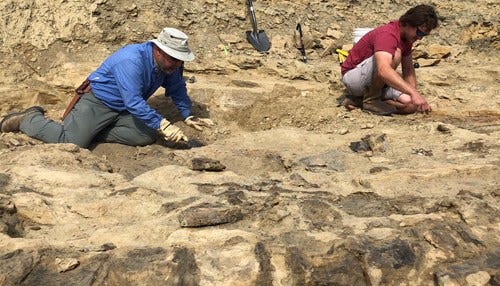Trove of Dinosaur Treasure Headed to Indy
 (courtesy: The Children's Museum of Indianapolis)
(courtesy: The Children's Museum of Indianapolis)
Subscriber Benefit
As a subscriber you can listen to articles at work, in the car, or while you work out. Subscribe NowA collection of dinosaur bones discovered and unearthed under the watchful eye of scientists from The Children’s Museum of Indianapolis is headed to the museum for preparation and eventual display in the new Jurassic Paleo Prep lab at the museum. The lab, part of the Dinosphere exhibit, is scheduled to open September 10.
The museum says dozens of scientists spent the last three months scouring a one-square-mile plot near Cody, Wyoming called the Jurassic Mile. The discovery was an archaeological jackpot with an abundance of dinosaur fossils.
“This summer’s Mission Jurassic dig season was an an extraordinary example of how science can reveal the stories of how giant, ancient beasts lived so long ago.” said Jeffrey Patchen, president and CEO of The Children’s Museum of Indianapolis.
Patchen says the collection will “paint a more complete picture” of what life was like when dinosaurs roamed the Earth. The museum says the crew discovered bones of long-necked, long-tailed beasts, which it believes to be 80-foot-long plant-eating sauropods.
“We have gained great insight from the jumble of bones and logs in the channel deposit along with the wonderfully preserved bones in the pond site,” said Professor Phil Manning, lead scientist, Mission Jurassic. Manning said it is extremely rare to find so many bones, tracks and fossil plants all within a single site.
The museum says more than seven tons of fossil material was excavated and transported to The Children’s Museum of Indianapolis. Teams are continuing to excavate more fossils this month.
“It provides real life examples of the scientific processes we can share with children and families in our Dinosphere exhibit and throughout the world, “ Patchen said.
In addition to the team from The Children’s Museum, the dig also has scientists from the United Kingdom and Netherlands.
Some of the fossils will also be sent to researchers in Canada and a U.S. Department of Energy lab run by Stanford University.
